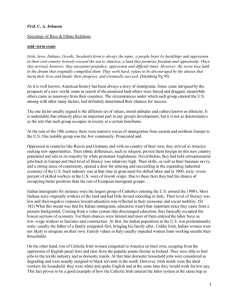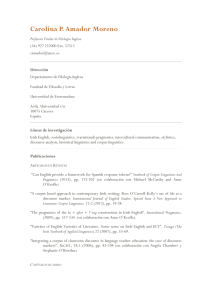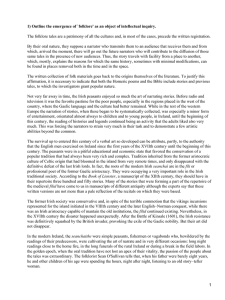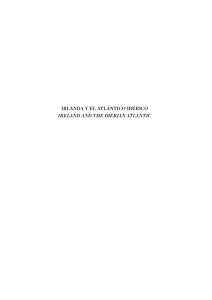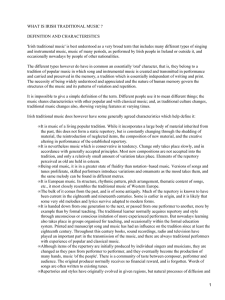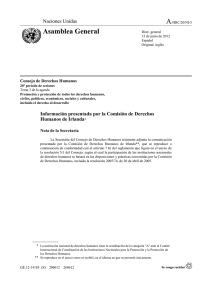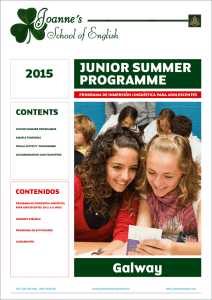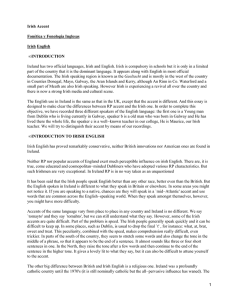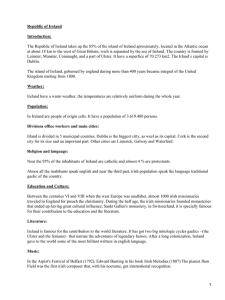Making the Case for Irish through English: Eco
Anuncio
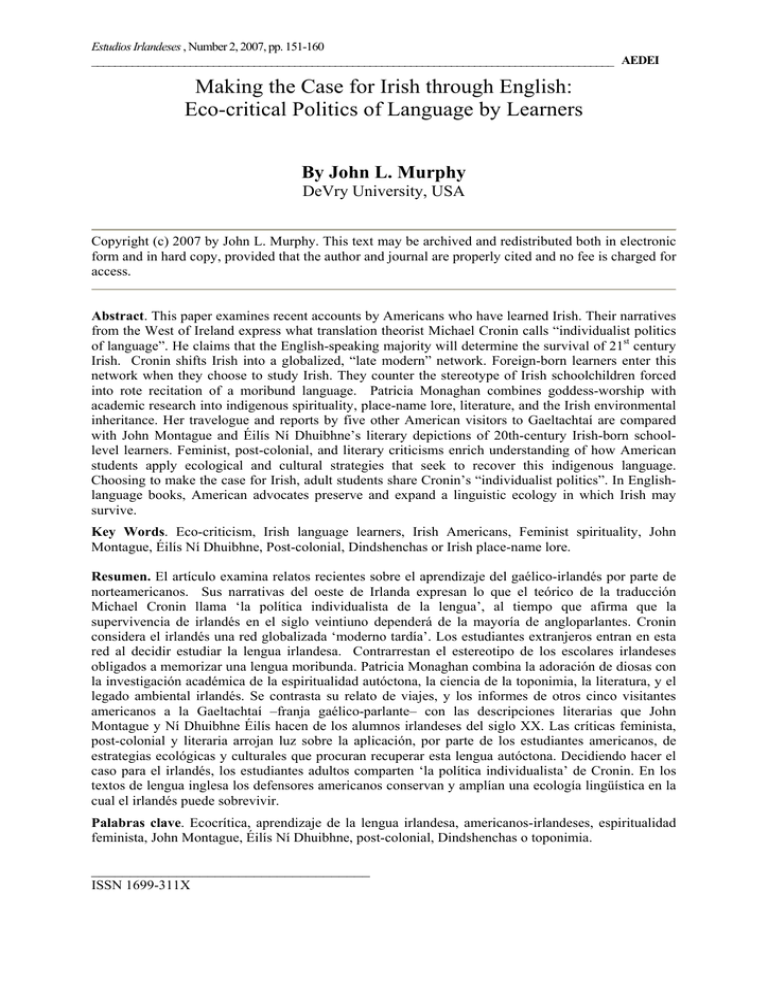
Estudios Irlandeses , Number 2, 2007, pp. 151-160 __________________________________________________________________________________________ AEDEI Making the Case for Irish through English: Eco-critical Politics of Language by Learners By John L. Murphy DeVry University, USA Copyright (c) 2007 by John L. Murphy. This text may be archived and redistributed both in electronic form and in hard copy, provided that the author and journal are properly cited and no fee is charged for access. Abstract. This paper examines recent accounts by Americans who have learned Irish. Their narratives from the West of Ireland express what translation theorist Michael Cronin calls “individualist politics of language”. He claims that the English-speaking majority will determine the survival of 21st century Irish. Cronin shifts Irish into a globalized, “late modern” network. Foreign-born learners enter this network when they choose to study Irish. They counter the stereotype of Irish schoolchildren forced into rote recitation of a moribund language. Patricia Monaghan combines goddess-worship with academic research into indigenous spirituality, place-name lore, literature, and the Irish environmental inheritance. Her travelogue and reports by five other American visitors to Gaeltachtaí are compared with John Montague and Éilís Ní Dhuibhne’s literary depictions of 20th-century Irish-born schoollevel learners. Feminist, post-colonial, and literary criticisms enrich understanding of how American students apply ecological and cultural strategies that seek to recover this indigenous language. Choosing to make the case for Irish, adult students share Cronin’s “individualist politics”. In Englishlanguage books, American advocates preserve and expand a linguistic ecology in which Irish may survive. Key Words. Eco-criticism, Irish language learners, Irish Americans, Feminist spirituality, John Montague, Éilís Ní Dhuibhne, Post-colonial, Dindshenchas or Irish place-name lore. Resumen. El artículo examina relatos recientes sobre el aprendizaje del gaélico-irlandés por parte de norteamericanos. Sus narrativas del oeste de Irlanda expresan lo que el teórico de la traducción Michael Cronin llama ‘la política individualista de la lengua’, al tiempo que afirma que la supervivencia de irlandés en el siglo veintiuno dependerá de la mayoría de angloparlantes. Cronin considera el irlandés una red globalizada ‘moderno tardía’. Los estudiantes extranjeros entran en esta red al decidir estudiar la lengua irlandesa. Contrarrestan el estereotipo de los escolares irlandeses obligados a memorizar una lengua moribunda. Patricia Monaghan combina la adoración de diosas con la investigación académica de la espiritualidad autóctona, la ciencia de la toponimia, la literatura, y el legado ambiental irlandés. Se contrasta su relato de viajes, y los informes de otros cinco visitantes americanos a la Gaeltachtaí –franja gaélico-parlante– con las descripciones literarias que John Montague y Ní Dhuibhne Éilís hacen de los alumnos irlandeses del siglo XX. Las críticas feminista, post-colonial y literaria arrojan luz sobre la aplicación, por parte de los estudiantes americanos, de estrategias ecológicas y culturales que procuran recuperar esta lengua autóctona. Decidiendo hacer el caso para el irlandés, los estudiantes adultos comparten ‘la política individualista’ de Cronin. En los textos de lengua inglesa los defensores americanos conservan y amplían una ecología lingüística en la cual el irlandés puede sobrevivir. Palabras clave. Ecocrítica, aprendizaje de la lengua irlandesa, americanos-irlandeses, espiritualidad feminista, John Montague, Éilís Ní Dhuibhne, post-colonial, Dindshenchas o toponimia. ____________________________________ ISSN 1699-311X 152 How Americans visiting in the West of Ireland learn Irish expresses what Michael Cronin calls an “individualist politics of language” (2006: 58). My essay explores how learners embody this ‘politics’ through an ecocritical response that links language to landscape. Cronin asserts that English speakers will decide if Irish survives. Its “intrinsically transcultural status” provides “an invaluable ally for an enhanced relatedness between (and within) self and environment” (2006: 58). The Revivalist construction of ‘communitarian utopianism’ collapsed; Cronin insists for Irish re-formation within ‘late modern’ globalization. ‘Virtual’ Irish has begun. Irishlanguage learners use the Internet, CD-ROMs, and language-learning software to communicate across the global diaspora. Recently, learners from throughout the world (and those not only of Irish descent) come to Ireland to adopt the language in its native habitat. They hope to transplant Irish. American authors enter the Gaeltacht. They receive the Irish language at its communal source. They widen the Irish-speaking community beyond its traditional territories. Patricia Monaghan revives dindshenchas in The Red-Haired Girl From the Bog (2003). Rosemary Mahoney, in Whoredom in Kimmage (1993) battles female codding with her sudden burst into Gaeilge. Nikki Ragsdale, interviewed in Beo (2003), speaks in Irish of how she mastered sean-nós. Lawrence Millman’s acerbic Our Like Will Not Be There Again (1977) evokes a rapidly eroding Gaeltacht. Kevin O’Hara, as Last of the Donkey Pilgrims (2004), circles the island with Missie and cart; O’Hara’s linguistic talismans ward off spirits and Yanks. Anthropologist Lawrence Taylor acquires Irish from Donegal informants, for Occasions of Faith (1995). Steve Fallon, in Home with Alice (2002), tests his emerging fluency as he visits Gaeltachtaí. Liam Ó Cuinneagain tells Fallon that Irish may wither as community speech, only to survive as a networked language. Acting out Cronin’s suggestion, learners transplant John Montague’s metaphor of ‘a severed tongue’. Their individual interventions transmit the Irish language by their narratives and actions throughout a global community with Cronin’s ‘intrinsically transcultural status’. These visitors assert Cronin’s ‘individualist politics’. We need not accept that the 21st century demands a binary ‘either-or’ solution to linguistic –and I add ecological– survival. One language surges over Europe; English drowns Irish. The alternative provides an analog model. Rather than English eliminating or excluding native competition, individual activists opt for innovation. Analog may have become outmoded in electronics as digitization dominates, but audio aficionados prefer the former’s warmth to the sterility of ones and zeros. Learners choose analog sounds: the ‘both/and’ solution. In English, Americans preserve linguistic ecology for Irish to survive, and perhaps thrive. This paper applies eco-critical theory to analyze Cronin’s ‘individualist politics’ within learners’ accounts. An ecologically informed literary criticism provides a foundation for understanding the effects of a learner’s decision to enter Ireland and to study the language while exploring the land. Ecocritics acknowledge how language protects and propagates cultural diversity. Language within natural macrocosms resists stasis. Lawrence Buell asserts that “the phenomenon of literature-and-environment studies is better understood as a congeries of semioverlapping projects than as a unitary approach or set of claims” (qtd. in Love: 5). Critics, Christopher Manes cautions, must clear linguistic space humbly. He blazes a path parallel to deep ecology, along which language reveals “ontological humility” that breaks “free from an obsession with human preeminence” (1996: 25). Rejecting declamation, critics listen. What they hear, Gary Snyder asserts, remains wild. Language “rises unbidden” and so “eludes our rational capacities”. Radically still raw, language “came from somewhere else”. He elaborates how civilization embodies chaos; the wild contains nature’s order. This “etiquette of freedom” respects “the Big Watershed”. Here, equal with one’s surroundings, people can “quit fighting dirt” (qtd. in Gerrard: 83-4). Rick Van Noy rejects human mapping through top-down management of static landscapes. Cartesian cartographical projections upon the terrain fail. Resisting a grid or the confines of adjectives, viewers 153 witness panoramas. “Rather than produce knowledge, as the map does, the sublime beggars it” (2002: 201). Finally, Maxine Sheets-Johnstone situates thinking as bodycentered. She rejects cultural differences which reduce nature to abstraction. Directed through the body, analysis steers an ‘evolutionary corrective’ away from theory’s dead-end. More similarity than diversity defines humanity. While languages differ, all share speech. People explain their world differently, yet each one possesses reason inherited through evolution (qtd. in Love: 61-2). William Howarth labels ecocritical revision as ‘deixis’. This applies language’s “ability to point” rather than its mimetic or representational function. Instead of naming or mapping landscapes, deixis creates meaning “from what is said or signed relative to physical space: I-you, here-there, this-that” (1996: 80). As “common as air or water”, deixis sets orientation or “relative direction” to signify what its knower expresses verbally. It does not name objects. It rejects margins, frontiers, or borders. It points to what objects do. Deixis distills nature’s essential meaning. Edward Said –examining post-colonial liberating power through writers celebrating creoles, hybrids, and compounds– calls this energy the “cartographic impulse”(1990: 79). With “nationalistic adumbrations of the decolonized identity”, Said says, comes “an almost magically inspired, quasi-alchemical redevelopment of the native language”. Said contends that Yeats shares with Caribbean and African writers “the predicament of a common language with a colonial overlord”. As the Celtic Revival dovetailed with decolonization, so geographical distance shrinks as language diffuses. Native speakers may become a minority, as within 21st century global English. For the Irish tongue, the independent nation designated it as an “endangered species”. But it rarely reproduced in captivity within the rest of the Free State. John Montague’s “A Lost Tradition” dramatizes this doomed attempt at rejuvenation. “The last Gaelic speaker in the parish” listens to a boy “When I stammered my school Irish”. This old man “crinkled/A rusty litany of praise:/’Ta an Ghaeilge againn aris...’” Yet school Irish left youth far from fluent. The ideal that patriotic children compelled to learn Irish would inspire their pragmatic parents faded. Although the elderly witness hails that (as a footnote translates) “We have the Irish again”, the experiment failed. “The whole landscape a manuscript/We had lost the skill to read”, the poet earlier laments. Montague’s “part of the past disinherited” cannot be adopted and nurtured. It remains buried, with “placenames, uncultivated pearls” the treasure scattered in the “Rough Field” of the poet’s adopted homeland of Garvaghey (1995: 33). Spoken in English, the harshness of the Irish “Garbh acaidh” eases. The link between landscape and inhabitant weakens. Later in the sequence “A Severed Head”, Montague converts this titular Celtic totem into colonial victim: “(Dumb,/bloodied, the severed/head now chokes to/speak another tongue–” (1995: 37). “A Grafted Tongue” twists botanic operation into imperial amputation. Plants transfer; humans dismember. No oracle, the tongue in Montague’s poem utters only “stuttering”. Imagining his ancestor, the speaker watches a child wearing a tally stick, the sign of punishment forced by the Crown but upheld by Irish-speakers resigned to raise English-literate children. Often, prepared thus for emigration, exile follows. Montague was born in Brooklyn, but as an infant was fostered out to his mother’s family in Tyrone. He evokes the generation after the tallystick. Although elders “still/speak the old tongue”, their child “may greet no one”. Unable “To grow/a second tongue”, the youth is cut off. New language blocks his return: “the turfcured width/of your parent’s hearth/growing slowly alien”. Irish dwindles. Elders bring tenuous continuity to the children of independence. The poet ends struggling to stitch what was severed. “Decades later/that child’s grandchild’s/speech stumbles over lost/syllables of an old order” (1995: 37). These syllables for many became forced babble. Despite the hopes of Éamon de Valera (another Irish baby returned from New York to his mother’s family three decades earlier) that his adopted land would adapt again its inherited language, too many students stuttered. Montague suggests that Irish cannot be grafted upon an English tongue. If the transfer succeeds, it must be nourished rather than forced. Michael Cronin likens ecological diversity to linguistic flourishing. Now, 154 resistors to anglicized monoculture must act. Volunteers arrive. Particularism inspires learners. Cronin incorporates Val Plumwood’s call for empathy with nature’s “particular aspects” (2005: 54). Impartiality must surrender to difference. Discrimination will preserve such fragile diversity only if grounded in reality. Our selves need connections with “well-known and loved” specific “animals, trees, and rivers”. Cronin compares linguistic to ecological nurturers. Through stewardship, the immediate microcosm initiates a wider understanding of global diversity. Globalization, Cronin argues, creates a “centrifugal flight from the uniformity of the centre” (2005: 55). Internationalism accelerates distinctions. Cronin’s ecological imperative parallels linguistic expansion. Site-specific environments enter open space. Cronin insists that differences weaken isolation. They provide “thickness and substance that comes from international distance, from a refusal to see the (polyglot) other as a simple projection of the (monoglot) self” (2005: 56). Universalism perfecting the particular draws learners of Irish into a virtually networked, not geographically limited, community. This may not be an ideal habitat. But given the erosion of the reserves of indigenous speakers in Gaeltachtaí, exportation may prolong Irish. It endures as an endangered species. It may live on, if not in captivity then in climates very different from its origins. Learners vow to recover Irish as an active mode of inquiry. Sensitivity for its surroundings inspires Patricia Monaghan to spend visits over two decades on “my own private dindshenchas, my song to the Irish places I know and their inner meanings” (2003: 14). She takes “my poet’s circuit” rightward, circling the island seeking “a calendar of ancient holidays” which are “embedded in the landscape”. Her ambitious account blends experience as a science writer with her current profession teaching “literature and environment” in Chicago. Combining her practice of goddess-worship with imaginative scholarship drawing from archaeology, myth, geology, and botany, she retrieves the pagan core beneath the Christian surface. Every page of Monaghan’s study invites an ecocritical reading. She pursues “loric power, the centripetal force that pulls us to places deeply linked to story” while integrating speculative with academic scholarship (2003: 84). Cronin finds globalization sparking “centrifugal flight from the uniformity of the centre” (2005: 55). Monaghan locates its opposite force. She aims for the heartland. Rooted in language and nature, with her training in science, her knowledge of Irish literature and history, and her own familial connections to her mother’s parents’ Irishspeaking Mayo, she directs her explorations within identifiable and scrutinized settings. She uses the Irish language as a divining rod, to point her to what lies beneath cognitive habit. For instance, she begins her deiseal route right-ward (in both senses) and notes how the Irish term connotes a sacred perambulation sun-wise, yet also designates the right-hand side. Finding evidence of the Cailleach (‘witch, crone, hag’ being her humbled English equivalents), Monaghan records that the term predates Celtic vocabulary. As a primordial goddess encompassing antiquity, evidence of the Cailleach’s perpetuity survives in placenames. “That she does so is testimony to a remarkable feature of Irish culture: the tenacity with which people cling to topographical names” (2003: 22). Entering a countryside ‘awash in names’, she applies etymology to physical characteristics, their historical or familial connections, and their mythic or poetic conjurings. Monaghan keeps her bearings by decoding Irish names. “I learned that their function was not to provide me navigational assistance but to anchor the present to the past”. The meaning of the Cailleach recalls when her primordial worshippers “entered a nameless land” six thousand years ago. “The tribe of the hag named whatever caught their eyes, leaving the leftovers to later settlers” (2003: 23). Monaghan offers a metaphor common among those interpreting Irish land through language. “Layer upon layer, like sedimentary limestone, names accumulated on the Irish landscape”. Early tribes “cemented that connection through place-names”. Thanks to “the unyielding conservatism regarding place-names”, many survived to the present. Colonists by Ordnance Survey mimicry mangled the spell between land and ‘loric’ power. Brian Friel’s Translations (1980) dramatizes this haunted retention on English maps of native Irish speech. Yet critics have challenged Friel’s 155 romanticized Gaels. While Monaghan indulges sparingly this temptation towards praising a brutal past, she also asserts the need for contemporary seekers to escape Western warmongering and environmental destruction. As Cronin and Plumwood encourage, she first grounds herself in the local. Like SheetsJohnstone, Monaghan places the body, and especially female receptivity to non-verbal substrata, as her topographic orientation. She aligns Howarth’s deictic polarities of “I-you, here-there, this-that”. As Van Noy sought from earlier surveyors, Monaghan minimizes her own presence. Linguistic markers guide her to the uncharted loric aura that still whispers – despite fractured anglicisms– its indigenous appellations. After her initial disorientation, the Irish language –for Monaghan as other seekers– holds the riddle’s clue. Fluency may elude learners, but they seek to hear what the tongue spoke before its severing. Nevertheless, linguistic roots disappear beneath Irish soil. Their intricate tenacity defies quick extraction of embedded evidence. Excavation of layers comprises one of the few depictions in English of learning Gaeltacht Irish. Éilís Ní Dhuibhne recounts not a foreign but a Dublin student’s stay, over a summer month at Irish-language college. The Dancers Dancing follows twelve-year-old Orla in 1972, back to her father’s Donegal. The school borders her relatives’ farms. As Orla summons the courage to meet her near-monoglot Irishspeaking aunt, she ponders landscape and language: Orla walks on down the blue road, through the straggling village. It is called Tír na Laidin, which she thinks means, appropriately, the Land of Latin. She has already found out that names often do not mean what they first seem to, however. Bun na Toinne, where her aunt lives, does not mean the bottom of the wave, but something about the family at Ton. Nobody knows what Ton means. Names, Máister Dunne has explained, are often more ancient than any other part of the language. They are so ancient that in some sense they are not even Irish, not even Celtic, and nobody knows what they mean. There are layers in language, as there are layers in the earth. Rock and clay and bog and growth and then more clay and bog and growth. You dig and dig and sometimes you don’t recognise what you find (1999: 185). Orla reacts like Monaghan to her terrain. Orla adopts her Irish to the scene, and draws what she believes a deeper meaning from stratiform soil. But, Orla realizes that words fail. Her limited Irish means she must roam over the site she seeks to know with fewer tools than its natives –such as her aunt– inherit. Like Monaghan’s Cailleach, Orla finds in Ton not a physical but a familial indicator. Its surface meaning does not necessarily provide the verbal key to unlock its topographic code. Orla, like Monaghan, knows, however, enough Irish to respect its prehistoric palimpsest. Celtic, and later English, settlers have tampered with the spoken evidence. Solutions may not appear, even for linguistic investigators. While neither narrator nor Orla mentions it, Tír na Laidin means not only ‘Land of Latin’. Niall Ó Dónaill defines Laidin also as “unintelligible speech” (1977: 740). This double-entendre denotes hidden language layers. Later speakers repeat primordial speech patterns laid down upon the ‘nameless land’, but descendants will not be able fully by speech “to recognise what you find”. For Orla, names conjure mystery beneath veiled Irish. Snyder’s idea that “language came from someplace else” emanating through wild, unintelligible speech correlates with Tír na Laidin. Said’s post-colonial ‘cartographic impulse’ generating creoles and hybrids beats through The Dancers Dancing. One chapter describes in English but through Irish syntax the first lesson given. Dublin and Derry girls despite school Irish still think in English. They cannot bend their linear, cognitive patterns into a spoken, serpentine Gaelic spiral. Like Montague’s student, Orla falters. With only ‘school Irish’, youth stammer before Montague’s old man or Orla’s gaeilgeoir aunt. Monaghan, contrarily, laughs at her limited ability. Free from inhibitions hobbling many Irish-born classroom learners, she offers her companion “lessons”: ‘But’, Maggie demurred, ‘you don’t actually know...’ ‘Hey!’ I shot back. ‘I know tubber and lios and bally. Once you’ve got “holy well” and “‘fort” and “town”, you just make the rest up. Ballinspittle? Town of the big spitters. Tubbercurry? Holy well of the Indian food. Lissivigeen? Fort of the vegetarians’ (2003: 95). 156 Monaghan delights in place-names that provide two intelligible meanings. She explains Irish roots; wordplay creates diglossic puns. Said’s “almost magically inspired, quasialchemical redevelopment of the native language” in Monaghan’s usage emerges not by “nationalistic adumbrations” but easy banter. Still, she displays a learner’s confidence. Monaghan emphasizes playful perceptions of Irish free from tallysticks, unfettered by severed tongues. She compares anti-imperialist rebellion to wildness of the Irish and their language. Snyder welcomes language that “eludes our rational capacities”. Orla fears scrutiny; Monaghan jokes. Although Monaghan never clarifies how she acquired Irish, whether or not she speaks it, she knows enough to inform her scholarship and enrich her speculations. She expands her subtitle’s direction: “the landscape of Celtic myth and spirit”. She incorporates Irish toponyms into playful consideration of how men and women view terrain differently. She interprets this distinction at a landmark embellished in Munster, where she circles back, closing her deiseal circuit. Examining Edmund Spenser’s denigration of ‘wylde Irish’, Monaghan imagines that colonizer’s rationale: “When culture is superior to nature, the wild must be tamed. The English needed the Irish to be wild; what good was their gift of civilization otherwise?” (2003: 234). This segues into the Crown’s attempts to punish the ‘Old English’ hibernicized into Irish speakers. Spenser asserts that a baby learns its mother’s speech first, so there its loyalties lie. Monaghan wonders: “Can the heart be Irish when the speech is not?” (2003: 236). She cites Tim Robinson’s claim that Irish “is an emanation of the land of Ireland”. She admits that despite her struggle, her Irish transcends syntax or vocabulary. It contains ‘embodied memory’, but what her grandparents spoke she cannot fully recover (2003: 237). She had as a child heard only curses as the Gaelic echo of her grandmother’s diminished fluency; she seeks now Irish’s sexual potential, and how its place-names embody the feminine principle that the Cailleach represents in her toponymic presence on maps and in lore. Monaghan’s quest back to the goddess lures her into the wild. On a deictic pilgrimage, she listens to the land’s names. The map directs her, but earth’s meaning lingers beneath verbal signifiers. She summarizes Jacques Lacan: a male child separated from its mother seeks jouissance, to recover his infant wholeness. The prelingual Imaginary ruptures and abandons the man. Between “the motherhaunted world and the world empty of her”, language mediates (2003: 237). For women, this gap vanishes. Never having left the Mother, females no longer need language. She supports this contention by examining the landscape of “myth and spirit” indicated as Danu’s Paps, Dhá Chíoche Dhanann (literally “Danu’s Two Breasts”). Beside the Kerry-Cork road two mountains loom, “named for a goddess both famous and obscure” (2003: 208). Danu derives from Indo-European “Donu,” as in the rivers Danube and Don, and the Tuatha de Danaan – three among many titles. Why did these prominences, she asks, receive an English synonym not for ‘breasts’, but for nipples –‘paps’? “While the Irish word draws attention to the hills’ shape, the English word emphasizes a different endowment”. Capping the hills’ ‘breasty roundness’, she observes their ‘visual aid’. Annette Kolodny shows how physical configurations become projected, to reflect “also the content of the group’s shared fantasies” (1996: 177). This Sapir-Whorf tendency, Kolodny argues, arises from unacknowledged or even unconscious cultural patterns extended by observers onto their surroundings. Sensible enough to know “our fantasies about the past reflect our own personal biases”, Monaghan hesitates. Imaginatively, she suggests why settlers six millennia ago denuded two hills of their tree cover, and then hauled up mortarless stones, hoisting pillars so high that they could be distantly discerned (2003: 210). Starting with our English names for these peaks, moving back through Irish to maternal goddesses Danu and/or Anu or Áine, she charts how “ancient silent monuments like Danu’s Paps drive us beyond the familiar". Placing nipples atop breasted hills symbolizes the worship of the feminine, and the desire to transform the landscape into the female form. It also shows how the ancient Irish, she reasons, saw the earth as one with the goddess. The language confirms this. With only English names, without pre-Celtic derivations borrowed into Irish, Danu’s loric power would have remained dormant. 157 Men and women share this named heritage. However, Monaghan chides, men do not hear when women speak. Therefore, she listens to the land. She explains her maneuver: “Just as my grandparents learned English to survive, so women learn the language of men” (2003: 237). This Spenserian mode asserts conquest by men and God-dominated Crown over women and the pagan Irish. It rejects the ‘ontological humility’ of Howarth’s deictic purpose for ecocritical language. Men cannot hear this “realm of the unspeakable”, she warns, unless they heed women’s reality. This ontology resists nature's constructs. Men may enter the wild to hunt and tame. Yet they return to women who apprehend a meta-linguistic silence beneath men's tales. Here, Monaghan proposes, the veiled mystery in ‘chíoche’ waits. Male informants view Paps only as stony nipples. Women, prodded by her interrogation, notice erect nipples. Cairns reify a natural woman nursing her child, or being embraced by her lover. The nipples complete human transformation of the naturally feminine-looking hill. This addition represents Sheets-Johnstone’s ‘evolutionary corrective’. The body, and not the mind, calibrates thinking attuned to nature. Monaghan emphasizes non-verbal thinking. But words preserve intuition. Cronin begins with the verbally particular and the ecologically specific. Local precision sustains linguistic culture. Five more narrators compress itineraries and limit analyses. Yet they share Monaghan’s scrutiny of natural landscape through native language. Rosemary Mahoney relates a common American learner’s experience. In studying the language, “a particularly strange and difficult one”, Irish “sounded familiar to me”. Like Monaghan, Mahoney had caught scraps of Irish from an elderly female relative. “It was an eerie thrill” to hear the language again. She links this excitement to a hidden habit among Irish women: “They seemed to have a secret among themselves . . . . They liked men yet were separate from them” (1993: xiv-xv). Mahoney associates hidden Irish with female resistance. On Inishmore, she thinks a fisherman addresses her in Irish, so thick is his accent in “his second language”. Aran Islanders “speak English in a mournful, faintly suspicious way, as though it pains them to be speaking such an unwieldy tongue” (1993: 71). Throughout her Irish year, she listens to how speech mirrors surroundings. Mahoney fears that fisherman’s invective. He is “very hard to understand”. She moves closer to hear him. The island pushes her back: “my boots slipping in the mud, sweater snaggling on a sharp rock in the wall” (1993: 73). His disdain foreshadows Mahoney’s reception in Dillon’s pub. There she spends much of four months of 1991 near Corofin in Clare. As late as the 1950s, a few native speakers lived nearby. Occasionally she finds a local with some Irish. Eileen O’Shea confronts what she sees as a clever rival from Boston. However, Eileen boasts only “platitudinous sayings that people flung out with bold authority” when their command was “rusty or incomplete” (1993: 102). How does Rosemary know this? ‘I am speaking Irish, Rose. You wouldn’t know what I’m saying at all’. ‘Tuigim. Tá beagán Gaeilge agam’, I said. [I understand. I have a bit of Irish.] Eileen clapped her hand over her mouth. ‘For the love of Mike’ . . . Had a dog come into the pub singing a little song they would not have been more surprised. ‘Did you learn that across in America?’ I told them I learned it here in Ireland, when I was younger. I told them the truth: my Irish was terrible. Conor looked at Eileen. ‘Think of it! A Yank spouting Irish!’ That was the usual reaction to any outsider who bothered to study this archaic, fading language – it was seen as a silly joke or trick (1993: 102). Mahoney’s ‘cúpla focail’ barely silences Eileen. But Rose resists Eileen’s condescension. By displaying Irish, these two women communicate at a more elemental level. Not in their limited vocabulary, but in their conscious reversion to “this archaic, fading language”. Underneath English and beneath Corofin, ghosts of Irish echo. Monaghan’s claim of feminine verbal subversion resonates in Rose’s strategy that counters Eileen’s patronizing. In another pub, researching “religious imagination” in southwest Donegal’s Gaeltacht, anthropologist Lawrence Taylor, like Mahoney, finds “the language changed my neighbors’ understanding of me” (1995: 20). 158 One night, he follows the locals around a side door after closing time. There, men speak about the salmon catch “as if that pursuit” fitted best Irish itself. Taylor wins the confidence of the villagers by learning Irish. He cites John O’Donovan’s mapping for the Ordnance Survey; for Taylor, as for his predecessor: “landscape and language are interdependent” (1995: 61). Van Noy explores how maps objectify; this process allows “literary cartographers” to distance their perceptions and so create their map. For Taylor, folk narratives do likewise. A glance at the map parallels a place-name’s appearance in a story. The place-name conjures up for its community audience a sight to see or rehear – via the landmarked story “tied to the place”. With Irish, Taylor interprets Donegal’s coastal nomenclature, its 19th century translations imparted by antiquarians also intrigued by Irish as a key to unlock the code kept within the scenery they surveyed. Entering into local stores of knowledge meant knowing Irish. This tradition continues for Taylor in the 1970s and 80s. For Nikki Ragsdale, music drew her into another hidden hoard of heard narratives. Neither of Irish descent nor influence, she recalled in an Irish-language Beo 2002 interview her first encounter. California-born, working in London, she accompanies a friend visiting her relatives: “Chuaigh an teanga i bhfeidhm go mór orm”. (“The language made a big impression on me”.) She hears it first at An Cheathru Rua in Connemara; she learns Donegal Irish to become both a singer and a fluent advocate for the language in San Francisco. The tug had been emotional, as for Monaghan and Mahoney: “Chuala mé an ceol agus an sean-nós chomh maith le linn an turais sin agus bhí mé tógtha leo ón nóimead sin”. (“I heard such great music and sean nós while on that tour and I was taken with them from that moment”.) Spoken and sung, Irish transforms her. Unlike Monaghan and Mahoney, Ragsdale imagines no atavistic attraction. She lacks any Irish background. No link between genealogy and language acquisition exists. Searching for wholeness, all three women select Irish to lead them into productive creativity. Lawrence Millman recorded seanachaí, or storytellers. As Monaghan imagined her Mayo grandmother giving up Irish for practical pig selling, so Dingle’s Tómas Walsh admits its limits, tied to environment: “I often think Irish is a language for the sea, like the sea. We called it deisbhéalach – ‘swift in the mouth’ . . . “you need a language like that, that wouldn’t make you lonely” (1992: 20). But, in Tralee selling cows or sheep, “English is the language for making your bit in the world. The Irish is all right between ourselves, but if I go to Boston tomorrow morning, and meet you in the streets, I couldn’t speak a word of Irish to you. There”. This mercantile scene, as Monaghan argues, rejects Irish language, antiquity, and respect. Seán Murphy, of An Cheathru Rua, reports: “They spoke it like churning the butter”, common and therefore unremarkable action. Murphy wonders why the language now gains prestige far from his Gaeltacht. Governments should support small farmers, not urban activists. He asks a girl passing from the local Irish-language summer school when she last said the rosary. Twice she shrugs silently. “The language will be buried” as he and his neighbors die, he predicts (1992: 34). Another layer will be added to the soil where students such as Orla tread. Millman, conscious of his 1975 romanticism, imagines sheep bleating in Irish. He links this to the “landscape of the dying West” (1992: 111). For Carna’s Tadhg Sugrue, “History dictates that he remain passive, like the land” (1992: 82). Unlike Monaghan, Millman finds the earth exhausted. It reflects ruin: “if some people derive their features from where they live, others can take on the feelings of their geography, and Tadhg has become Connemara inside. After a fashion, he is growing bereft of people” (1992: 76). The ground depleted, the language wearies. Speakers dwindle until only sheep utter its “unintelligible speech”. Kevin O’Hara speaks to sheep as he rides his donkey cart, pulled by Missie, around Ireland in another circle but, as he learns too late, counter-clockwise. His luck threatened, he shouts Irish to ward off fears as he tries to sleep in a fairy-fort. Earlier, he ignores gawking Yank tourists. One suggests “I was either a Gaelic speaker or deaf and dumb” (2004: 73). In Donegal, O’Hara’s employment of Irish to create distance foreshadows his own detachment from natives, among “these saltsprayed slopes where the descendants of the uprooted Celts huddle, doggedly clinging to their language, religion, and music” (2004: 159 329). An Irish speaker asks him: “Do you find us coastal dwellers strange?” O’Hara responds: “I only wish I knew your language so I could better understand all that’s around me”. She assures him: “The old language is but at the butt of your tongue”. This reaction appears the exception; natives retreat into the language, as Taylor discovered, to deter intrusive tourists and “blow-ins”. If visitors attempt Irish, defensive or daunting discourse follows, as Mahoney also relates. Delving beneath the superficial to learn how the language evokes its landscape inspires O’Hara. But for him, unlike Millman, cultural separation widens when he meets more Irish speakers. Passing with Missie, O’Hara suffers stares “with the frank curiosity I had come to expect from the Gaeltacht folk”. When he seeks lodging, “the elderly occupants apologized, speaking Irish only, but indicating they couldn’t house an asal in their tiny byres with a solitary cow and a few hens. I had to wonder how they scraped out a living in such miserable circumstances, and couldn’t hold it against them when they turned me away”. The pathetic fallacy applied, language matched to misers, the dismissal of Irish to the uprooted, huddled, and the elderly, returns, if gingerly. O’Hara understands enough Irish, like Mahoney, to learn how many Irish reply to brash Yanks. O’Hara reaches Roundstone Bog, another ‘lonely’ Gaeltacht. “It was no surprise now to find Irish pushed to the desolate but beautiful extremities of the island” (2004: 398). A redheaded “sixtyish bloke” sniggers to his cronies. “Oh, to own the Irish tongue, I said to myself, knowing the joke was at my expense. Wouldn’t I do my best to unplug that human wireless, and fast”. He trudges on “through this filthy squall”. This Gaeltacht resists. “I had been told I would find Connemara folk more fierce and independent than the other Gaeltachts, a people indigenous to their stony land, rather than driven there by Plantation and partition in the North”. Travelling in 1979, O’Hara avoids danger in Derry and Belfast only to find his roughest ride through a boggy gauntlet of harsh spectators, not hospitable speakers. If O’Hara and Millman find Irish in its heartlands as harsh as the Western Irish themselves, Steve Fallon follows Taylor and Ragsdale’s calmer encounters. Like Mahoney, Bostonian Fallon had heard Irish as a child. Aunt Alice literally now haunts his 2001 “journey into Gaelic Ireland”. Fallon accounts for “racial memory” with the language by his family connection, as had Monaghan and Mahoney (2002: 89). He accepts Cronin’s imperative to “make the case for Irish in English”. A mature student, he represents the individualist politics of networked learners; he studies via the Internet and tapes before coming to Ireland. This web-linked diaspora has been credited for recent rises in positive native attitudes towards Irish beyond Gaeltachtaí. Yet in An Cheathru Rua, as he cycles about, Fallon glides by locals as distant from him as the rosary-less girl must have found her recriminating Seán Murphy. Native Irish survives defensively. Fallon sees signs marking the Gaeltacht “as part of the landscape”, but these environs – while they teach visitors like him and Ragsdale – repel strangers (2002: 50). Still, this is where eavesdropping on a “conversation as gaeilge is as natural as rain” (2002: 129). Here is where Irish “can be allowed to grow and develop, and, at the same time, where it can be protected”. Murphy, a few miles away, resented government grants for gaeilgoirí; Fallon defends “these natural environments” for Irish. “Think of the Gaeltacht as having the right kind of soil and the optimum climate for a certain crop you want to grow”. Activists, he adds, treat these terrains as “treasures, ‘holy’ sites” where pilgrims “drink from the fountain of history and fluency”. Here we come full circle, deiseal preferably, to Cronin’s match of the particular advocate with this indigenously suited ecosystem. Fertile yield from this Irish harvest will come from not only those who stay in its West, but among those who spread its language globally, as individualists broadcasting many messages. Eco-critical theory urges literary critics to study how language works to ground speech and texts within cultural terrain. Whether indigenous or transplanted, grafted or global, the 21st century fate of the Irish language depends upon the dominant, English-speaking majority. Cronin reminds us to act locally as well as to think globally. Ecologically aware strategies for human survival apply to linguistic habitats. In choosing to enter Ireland and learn its native language within its natural environment, American learners assert 160 Cronin’s ‘individualist politics of language’. Unlike Orla or Montague’s boy, they choose to learn Irish. They will transplant it within English-language narratives and through “late modern” electronic and textual networks that tie those who speak and learn Irish: whether from birth, in school, or as second-language adult students. Making the case for Irish through English, its advocates study the language within its natural setting. They also remind us that Irish –for the first time in millennia– may have to be rescued from its indigenous birthplace. Uprooted, through texts and cyberspace, it spreads across the Net and within databases. This radical intervention may determine if Irish survives beyond our century. Works Cited Cronin, Michael. 2005. Irish in the New Century/An Ghaeilge san Aois Nua. Dublin: Cois Life. Fallon, Steve. 2002. Home with Alice: A Journey into Gaelic Ireland. Melbourne: Lonely Planet. Gerrard, Greg. 2004. Ecocriticism. The New Critical Idiom series. London: Routledge. Glotfelty, Cheryll, and Harold Fromm, eds. 1996. The Ecocriticism Reader: Landmarks in Literary Ecology. Athens GA: U of Georgia P. Howarth, William. 1996. “Some Principles of Ecocriticism.” Glotfelty and Fromm 69-91. Kolodny, Annette. 1996. “Unearthing Herstory: An Introduction.” Glotfelty and Fromm 170-181. Love, Glen A. 2003. Practical Ecocriticism: Literature, Biology, and the Environment. Charlottesville: U of Virginia P. Mahoney, Rosemary. 1993. Whoredom in Kimmage: Irish Women Coming of Age. Boston: Houghton Mifflin. Manes, Christopher. 1996. “Nature and Silence.” Glotfelty and Fromm 15-29. Millman, Lawrence. 1992 (1977) Our Like Will Not Be There Again. Notes from the West of Ireland. Fredonia NY: White Pine P. Monaghan, Patricia. 2003. The Red-Haired Girl From the Bog: The Landscape of Celtic Myth and Spirit. Novato CA: New World Library. Montague, John. 1995. Collected Poems. Winston-Salem NC: Wake Forest UP. Ní Dhuibhne, Éilís. 1999. The Dancers Dancing. Belfast: Blackstaff. Ó Dónaill, Niall. 1977. Foclóir Gaeilge-Béarla. Baile Átha Cliath: Oifig an tSoláthair. O’Hara, Kevin. 2004. Last of the Donkey Pilgrims. New York: Tom Doherty/Forge. Ragsdale, Nikki. 2002. “Agallamh Beo le hÉamonn Ó Dónaill.” Beo. Eagrán 18 (Deireadh Fómhair). October. http://beo.ie/index.php?page=an_ghaeilge_i_gcein&content_id=171 Said, Edward. 1990 (1988) “Yeats and Decolonization.” Field Day Pamphlet. Rpt. in Nationalism, Colonialism and Literature. Ed. Seamus Deane. Minneapolis: U of Minnesota P. 69-95. Taylor, Lawrence J. 1995. Occasions of Faith: An Anthropology of Irish Catholics. Philadelphia: U of Pennsylvania P. Van Noy, Rick. 2002. “Surveying the Sublime: Literary Cartographers and the Spirit of Place.” The Greening of Literary Scholarship: Literature, Theory, and the Environment. Ed. Steven Rosedale. Iowa City: U of Iowa P. 181-206.
